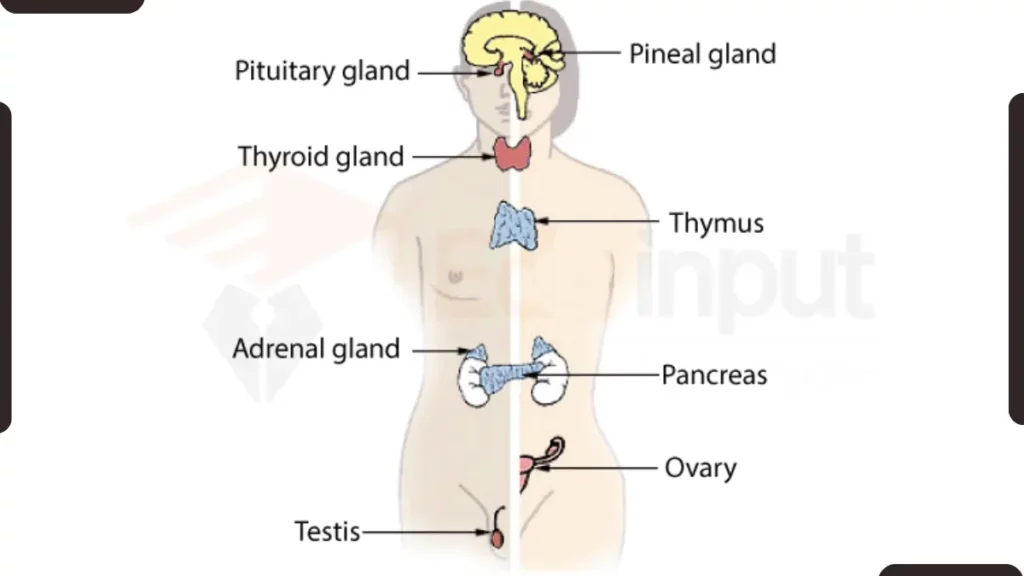Endocrine System – Anatomy, Types, Functions, and Mechanisms
The endocrine system is a complex network of glands and organs that release hormones into the bloodstream. Hormones are chemical messengers that regulate various bodily functions, including growth, metabolism, reproduction, and stress response.

Types of Endocrine System
There are two main types of endocrine systems:
1. Neuroendocrine system
The neuroendocrine system is a hybrid of the nervous and endocrine systems. It involves specialized neurons that release hormones in response to signals from the central nervous system.
2. Classical endocrine system
In the classical endocrine system, hormones are produced and released by specialized endocrine glands directly into the bloodstream.
Also Read: What is Anatomy?
Anatomy of the Endocrine System
The endocrine system consists of a variety of glands and organs, each with a unique function. Some of the key components include:
1. Endocrine glands
These glands produce and release hormones into the bloodstream. Major endocrine glands include the thyroid gland, adrenal glands, pituitary gland, pineal gland, and parathyroid glands.
2. Hypothalamus
The hypothalamus is a region of the brain that serves as a critical link between the nervous system and the endocrine system. It produces hormones that regulate the pituitary gland’s activity.
3. Pituitary gland
The pituitary gland is often referred to as the “master gland” because it secretes a variety of hormones that regulate other endocrine glands.
4. Pineal gland
The pineal gland produces melatonin, a hormone that regulates sleep-wake cycles and circadian rhythms.
Endocrine System Organs
In addition to the endocrine glands mentioned above, several other organs also contribute to the endocrine system:
1. Gonads (testes and ovaries)
Gonads produce sex hormones (e.g., testosterone and estrogen) that influence reproductive functions and secondary sexual characteristics.
2. Parathyroid glands
Located near the thyroid gland, these glands regulate calcium levels in the bloodstream.
3. Thymus
The thymus gland plays a role in immune system development, producing hormones that help mature T-cells.
4. Kidneys
The kidneys release hormones like erythropoietin, which stimulates red blood cell production, and renin, which regulates blood pressure.
5. Gastrointestinal tract
Various cells in the gastrointestinal tract release hormones that influence digestion and nutrient absorption.
Functions of the Endocrine System
The endocrine system plays an important role in regulating many bodily functions, including:
1. Metabolism
Hormones like insulin and thyroid hormones control how the body converts food into energy.
2. Growth and development
Growth hormone (produced by the pituitary gland) is essential for childhood growth and maintaining tissue repair and muscle mass in adulthood.
3. Reproduction
Sex hormones (e.g., estrogen and testosterone) control reproductive functions and secondary sexual characteristics.
4. Immune response
Hormones like cortisol and thymosin regulate the immune system’s response to stress and pathogens.
5. Fluid and electrolyte balance
Hormones like aldosterone and antidiuretic hormone (ADH) help maintain fluid and electrolyte balance.
How Does the Endocrine System Work?
The endocrine system operates by releasing hormones into the bloodstream. Hormones travel throughout the body and interact with specific receptors on target cells. This interaction triggers a response in the target cell, which can alter its function or behavior.
Hormones are released from endocrine glands in response to various stimuli, including:
- Neural signals – Nervous system can stimulate the release of hormones from endocrine glands. For example, when the body is stressed, the nervous system triggers the release of cortisol from the adrenal glands.
- Other hormones – Hormones can also stimulate the release of other hormones. For example, the growth hormone-releasing hormone (GHRH) released from the hypothalamus stimulates the release of growth hormone from the pituitary gland.
- Changes in blood chemistry – Changes in blood chemistry, such as blood sugar levels or calcium levels, can also trigger the release of hormones. For example, when blood sugar levels rise, the pancreas releases insulin to lower blood sugar levels.
Also Read:

 written by
written by 

Leave a Reply